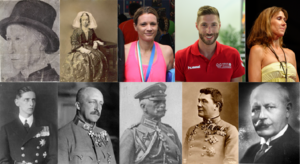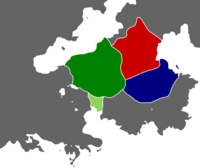Lushyods: Difference between revisions
| Line 51: | Line 51: | ||
===Decline and Fall of the Viragstag=== | ===Decline and Fall of the Viragstag=== | ||
{{see also|Blühen | {{see also|Blühen Wars|Viragstag}} | ||
===Kastory Wars=== | ===Kastory Wars=== | ||
===Ikonkivorrag=== | ===Ikonkivorrag=== | ||
Revision as of 10:48, 22 September 2022
 1rst row : King Frigyen II, Anna Kationna, Jada Aller, Hug Moritz, Saichel Morva 2nd row : Prince Farza, Vilvo Orbraggar, Hortankh Bolsar, Srav Kann, Marveil Urshlo | |
| Total population | |
|---|---|
| 25.28 million (2020) | |
| Regions with significant populations | |
| 18 million | |
| 3.96 million | |
| 1.85 million | |
| 1.47 million | |
| Languages | |
| Lush, Ostro-Ludzic, Nahuatl | |
| Religion | |
| Docetic Nazarism, Alban Nazarism, Aletheic Nazarism, Judaism | |
The Lushyods are originally a Ugric people who, through successive migrations, came to conflict with the Ludic principalities and chiefdoms that had succeeded to the Tervigian Empire. The Lushyods ultimately successfully pushed south and settled in the Furodomark, a region of south-west Drevstran. From this first proto-state two kingdoms emerged : the Drevstag and the Lushyodorstag. Other Lushyod kingdoms would emerge from these proto-states, including the Viragstag in modern day Brumen.
There are currently an estimated 25 million ethnic Lushyods and their descendents worldwide, of whom 18 million live in modern days Drevstran. Significant groups of people with Lush ancestry live in neighborhing countries (Ostrozava, Brumen, Ludvosiya...) but also in other continents with a strong diaspora in countries such as Zacapican.
Lushyods can be divided into several subgroups according to local linguistic, cultural characteristics, and religion. Such groups include the Vörönyak jews, the Havari of Brumen, and the Lush-Nahuas of Zacapican.
Name
The origin of the Lushyod' name is uncertain. There are mainly two ompeting explanation for its etymology : the first refer back to old Lush songs and legends to explain Lushyod as referring back to the name of an old medicinal herb that covered the "Pastures of our ancestors" and granted them long and healthy lives, if not immortality, until one day all the herb died forcing the ancestors of the modern Lushyods to abandon their homeland and migrate in quest of the medicinal herb. While popular among Lush Protochronists circles, the hypothesis is still defended by some historians due to the cultural importance of the Immortality Quest among early Lushyods and thus, while the events recorded in the legends never happened, the famed medicinal herb became the inter-tribal symbol of the Lushyods.
The other explanation simply consider Lushyod to have the same origin as Ludz or Ludic : the proto-Lud word for "people". This would follow the habit of Eastern Belisarians chroniclers to refer to Ludic people, or identify separate Ludic people, by their specific pronounciation of this proto-word. This would be especially in line with how Gothics - and afterward Audonians - had difficulties differenciating the Lushyods from neighboring Ludic people. However, other historians and linguists consider this explanation to overplay these difficulties - Lush military warfare, customs, and language make it hard to believe they could be mistaken as Luds for long - and to base itself on flimsy linguistic evidences.
History
Origin
The ethnogenesis of the Lushyods is an hotly debated question. A Language isolate in eastern Belisaria, they seem to have ancient but tenuous genetic ties to the Farsians while their ties to the Ludic people are more recent and stronger. The Lushyods left Protohistory when they migrated southward, following the Road of the Lakes across Ludvosiya, driving Ludic tribes before them further south into Tervingia. They would continue to live a semi-nomadic lifestyle between Lake Kulpanitsa and the Smaller Seas, raising sheep and horses while also fishing and extracting other ressources from the seas, like salt. Looting and the organisation of raiding parties represented a sizeable share of the proto-Lushyod economy.
8th and 9th centuries AD
By the middle of the 8th century, Lushyod razzias into the Drev river valley changed in nature as the Lushyods began a new cycle of mass-migration southward both by horse and by boat. After multiple successful raids across the Drev River Valley, they settled between Lake Kulpanitsa and the hills of the Furodomark, lands taken from the Kingdom of Morinia. Led by a Warchief known as Garza I, they completed their conquest of the Furodomark and Lusatia by 800 AD, founding the city of Pyrovegy which would become the capital of the Lushyodorstag.
At the death of Garza I in 811, the leadership of the tribes was divided among his two sons as per Lushyod customs. The second born, Worsak, received no land but enough men and cattles to survive. He then migrated with his troop to the north-east, conquer the shores of the Drev river and subjugating the Ludic tribes living there. His conquest was made more acceptable to the proto-Ludz when in 816 he converted to Aletheism leading to a fusion between the elites of the two people. His convertion is generally considered to mark the official birth of the Kingdom of the Drev.
In 829 when Worsak I died, tribal leadership was once again divided among his sons. Garsa I suceeded him as Drevkorrag (King of the Drev) while his second son Havar I led one Lushyod tribe and an unknown number of Ludic bondsmen southward across the Kastory Mountains to settle on the northern shore of Lake Blühen, founding the city of Virazag. He then proclaimed himself "King of Virag" (Virakorrag) at the healm of a new kingdom.
Meanwhile, the Lushyodorstag became infamous as a nest of pirates and raiders, locked in conflict with the kingdoms of Morinia and Suebia. It's during that time that the teachings of the heretic teacher Mar Kusail (also known by his Latin name of Caecilius or Cecil the Illusionist) became popular within the Furodomark. The Lushyods of that state had remained polytheists despite the popularity of Alban Nazarism among the Vestrozavans they dominated. In 823 AD, king Garza III was officially baptised and the majority of the Lushyods followed suit. Garza III also proclaimed himself "Protector of all Nazarists" and remained non-denominational in his faith, encouraging the spread of both Docetism and Albanism.
The second half of the century was marked by the southern expansion of both the Lushyodorstag and the Viragstag, facing mainly the Suedians and Gothic states of Morinia, Suedia, Sudentor, Waldreich, and Bewahren. The Viragstag notably would reach its maximal expansion while the Lushyodorstag took vast sways of lands from Suedia and created the vassal state of Elbogen giving their pirates and raiders access to the Periclean Sea.
